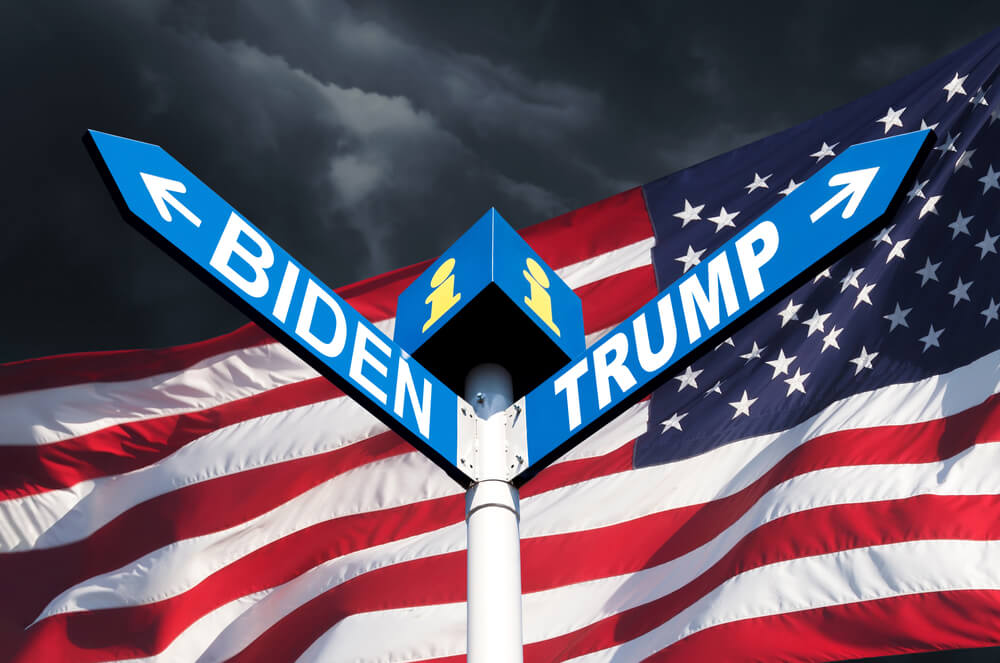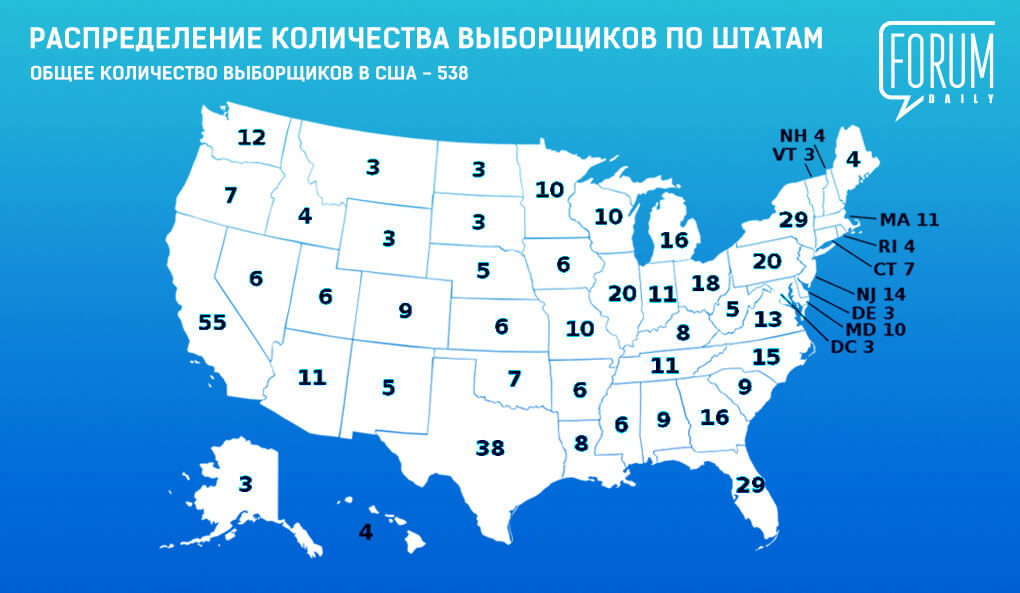How to choose the president of the United States: a simple explanation of the complex electoral system
The electoral system in the country is so complex that not everyone understands it even among Americans. ForumDaily has laid out the entire process on the shelves so that Russian-speaking US citizens can also make an informed choice and understand what is happening.

Photo: Shutterstock
Voice of the people
Ukrainian Tatyana Murza has been living in Maryland for over ten years. She came to America to study, then married. In 2013, she received citizenship, and already voted in the previous presidential elections. It is recognized that by that time already understood something in American politics. The citizenship test helped in which there were a couple of questions about the electoral system. She registered to participate in the elections she also received citizenship.
“When I received my passport as a US citizen, I simply checked the box “register me to vote,” says Tatyana Murza.
Registering to vote is the first and required step for all US citizens who want to elect a president. You can register both when obtaining citizenship and when passing your license, but at this moment you must already be a US citizen. However, if you have changed your residential address, you need to go through this procedure again. ForumDaily has already described in detail whole registration process.
Check whether you are on the lists of voters can be on the site Election Assistance Commissions. Also here you can register online.
A few days after a simple registration, Tatiana Murza received an invitation card to the elections by mail. It was written her name, surname and address of the polling station. She only had to come on election day and vote.
And here Tatyana had a reason to be surprised. Elections in the United States are not held on Sunday, like ours, but on Tuesday. This is because farmers used to have Saturday as a working day, on Sunday they went to church, and on Wednesday they went to the market. Therefore, they decided that Tuesday was the best day to express their will.
“There is no day off in honor of the elections, but everyone is released from work so that people can vote. And polling stations are open from early morning until late evening,” says Tatyana.
She came to the polls with a driver's license and an invitation. Her details were checked on the lists and pointed to the voting machine, where she was to cast her vote.
“They are somewhat similar to ATMs,” explains Tatyana. “There are candidates on the screen, you press the right button, you get a sticker with the inscription “I voted” and that’s it.”
Depending on the state, paper ballots can also be used for voting, which are then scanned, which makes the counting process faster. This is how the voting process looks like for all US citizens who are on election day in their state.
If on Election Day you will be out of state or in general abroad, then you can vote in advance.
To do this, you need to contact state government or local electoral office Election Assistance Commissions, order a ballot from them (the so-called absentee ballot), after receiving it, vote and send the ballot by mail back to the electoral office.
Long road to elections
Despite the fact that the final voting day is in November, the election campaign lasts about a year, or even longer. A series of internal party elections—caucuses and primaries—starts in February during the election year.
Caucuses are one of the most obscure forms of voting. Plus, the parties themselves conduct them differently. The essence of caucuses is this: ordinary members of the party and ordinary voters who support it gather in one place and discuss candidates for nomination. Party activists are trying to win the support of the maximum number of people present. At the end there is a vote.
Republicans vote simply - a tick in the ballot and then a vote count. The Democrats are becoming more entertaining: the supporters of the candidates disperse in different angles, debate among themselves and try to invite the voters to join their group. At the end, the number of participants in a group is calculated. If someone left, without waiting for the end, his voice is not counted.
The primaries are essentially the same as caucuses, but the form is much simpler - they are held as standard elections with ballots and polling booths.
As a rule, not only party members, but also ordinary citizens can participate in both primaries and caucuses, Registration. they indicated which party they supported. That is, if you indicated that you support the Democratic Party, you can take part in the Democratic primaries, and if you support the Republican Party, you can take part in the Republican primaries. The same person cannot participate in the primaries and caucuses of both parties.
The results of the Iowa caucuses and the New Hampshire primaries are like beacons for the entire further course of the campaign. Typically, the candidate who wins both states usually becomes the party's nominee. Over the past 40 years there have been only two exceptions:
- Bill Clinton, as recalls Vox, lost both states, but won the 1992 Democratic nomination;
- Joe Biden also lost both states this year, but eventually received a Democratic nomination.
Why do we need delegates
The goal of each candidate during caucuses and primaries is to collect the maximum number of votes. But even here, not everything is so simple - even during the primary elections, voting is indirect. In each state, Republicans and Democrats have a certain number of delegates. These are party members who are going to the National Convention in the summer, where the party will officially announce its single candidate. Whichever candidate wins the state gets the majority of delegate votes. Although candidates continue to collect votes by state until June, almost always the winner of the nomination is known long before the party gathering of both parties.
“The last time there was no candidate selected before the Convention was in the 1976 election, when Ronald Reagan and Gerald Ford sought the Republican nomination. Ford won the convention. And since that time, this has not happened again,” says Ilya Shapiro from the Cato Institute.
Republicans vs. Democrats
In the summer, after the National Conventions of Republicans and Democrats, the elections that we are used to - between two party opponents begin. As a rule, these are representatives of the Republican and Democratic parties, but sometimes other candidates can join the race.
For example, in 1992, during the confrontation of Democrat Bill Clinton and Republican George W. Bush, independent candidate Ross Perot and libertarian Andre Marrow joined the election. Ross Perot proved to be a fairly strong contender, he scored 19%, taking votes from Bush Sr., which in turn brought victory to Clinton.
However, since the time of the first US President George Washington, who was an independent candidate, not a single representative of third forces has managed to become head of state - this position has alternated between Republicans and Democrats and vice versa.
Electors decide everything
Presidential elections in America are indirect. Journalist Matthew Scheil with irony recalls that he did not immediately realize this:
“I realized that I was choosing, in fact, not the president directly, but the Electoral College, only by the age of twenty.”
Matthew implies a two-stage election system. Its essence is this. Each state is awarded a certain number of electors. It is equal to the number of state representatives in Congress and is determined by the principle: the more people living in a state, the more electors it has. For example, California has the most electors - 55, and in Wyoming and several other states their minimum number is only 3. In total - 538 electors, all of them together make up the Electoral College.
On election day, voters tick one of the presidential candidates, but, in fact, vote for the electors. Let us explain this by the example of abstract numbers. For example, in the state of N 10 000 people voted for the Democrat, and for the Republican - 10 001 people voted, which means that the latter wins. Suppose 5 electors are assigned to this state. Such voting results mean that all five electoral votes are being left to the Republicans - the voters delegate their right to vote to them and, figuratively speaking, indicate to the electors of their state who should be supported.
The principle described above, when a candidate who receives a majority in a certain state, takes all the electoral votes for himself, is called “the winner gets everything”. For example, Democrats traditionally win in California, which means that all 55 electors on the College will vote for a Democratic candidate.
Although there is no law that would oblige electors to cast their vote for a specific candidate, there were only a few cases in history when they did not vote as expected. And it still did not affect the final result.
The winner of a presidential election is determined by the number of electoral votes he receives—the one who can collect more electoral votes, rather than directly from the popular vote, wins. This, in fact, was clearly demonstrated by the 2016 elections, when Clinton received a majority of popular votes, three million more than her opponent, but Trump became president, receiving more electoral votes.
To win, a candidate needs to get 270 votes - half of the total number of the Electoral College (538) plus one.
Such a complex scheme in the United States is used to take into account the interests of sparsely populated states.
“If the count were based on pure votes, then the candidates’ entire campaign would be built in California, Chicago and New York, where the most people live,” explains Ilya Shapiro of the Cato Institute. — And so candidates have to pay attention to small states. After all, it is unfair if a person becomes president who won only seven states, but the most populous ones. What about the other 43?”
This system also has a significant disadvantage. “Five times in US history, the candidate who received the majority of the popular vote did not win the electoral vote. And this, of course, is also unfair,” states Ilya Shapiro.
In addition to Trump and Clinton, such mathematical-political injustice also occurred in 2000 in the confrontation between Democrat Al Gore and Republican George W. Bush. More than 51 million voters and 266 electors voted for Gore, while 50,4 million voters but 271 electors voted for Bush. Bush ultimately won.
The electoral college formally meets in December, and only then the winner is officially announced. In fact, America will know the name of the new president already on the evening of the voting day.
Read also on ForumDaily:
Red, blue, purple: how US states are divided by political views
The Trump-Biden race could end with the presidency of Nancy Pelosi: how is it possible
How much does the US presidential election cost and who pays for it
Battle for ObamaCare: How Trump and Biden Settle to Reform Health Care
Subscribe to ForumDaily on Google NewsDo you want more important and interesting news about life in the USA and immigration to America? — support us donate! Also subscribe to our page Facebook. Select the “Priority in display” option and read us first. Also, don't forget to subscribe to our РєР ° РЅР ° Р »РІ Telegram and Instagram- there is a lot of interesting things there. And join thousands of readers ForumDaily New York — there you will find a lot of interesting and positive information about life in the metropolis.












